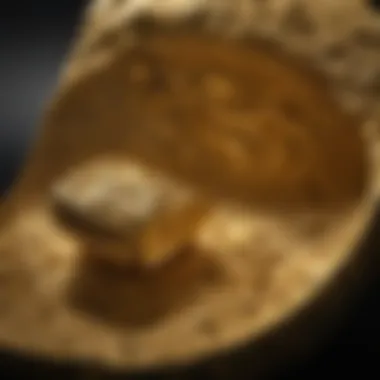Unveiling the Authenticity of Gold: A Comprehensive Guide for Discerning Enthusiasts


Rock and Fossil Identification
Gold enthusiasts must possess a keen eye for detail when determining the authenticity of their precious metal. Visual identification serves as an initial step in assessing gold, examining its color, shine, and overall appearance. Genuine gold has a distinct bright yellow hue that sets it apart from other metals. Moreover, authentic gold often exhibits a luster that is unmatched by imitations. To further solidify the authenticity assessment, collectors can turn to advanced methods that involve testing the specific gravity, magnetic properties, and conductivity of gold. These meticulous checks ensure that enthusiasts can confidently verify the purity and quality of their prized possessions.
Introduction to Gold Authentication
Gold authentication is a crucial aspect for enthusiasts and collectors seeking to verify the purity and quality of their precious metal possessions. In this comprehensive guide, we delve into the various methods used to determine the authenticity of gold, ranging from visual inspections to advanced testing techniques. Understanding the nuances of gold assessment not only safeguards investments but also ensures a deeper appreciation for the intrinsic value of this esteemed metal.
Why Authenticity Matters
Preserving Value
Preserving the value of gold is paramount in the world of precious metals. By ensuring the authenticity of gold items, collectors can be confident in their investment's worth, safeguarding against depreciation or loss of value over time. The key characteristic of preserving value lies in maintaining the original integrity of the gold, which is vital for long-term wealth preservation.
Ensuring Quality
Ensuring the quality of gold items not only enhances their aesthetic appeal but also speaks to the credibility of the collector or dealer. Authenticity guarantees that the gold piece meets the expected purity standards, contributing to its overall allure and desirability. The benefit of ensuring quality lies in cultivating a reputation for dealing in genuine and high-quality gold, establishing trust among fellow enthusiasts.
Avoiding Fraud
In a market rife with counterfeit products, avoiding fraud is essential for both novice and seasoned collectors alike. By discerning authentic gold from counterfeit replicas, enthusiasts can protect themselves from financial loss and maintain the integrity of their collections. Understanding the unique features typical of fraudulent gold items empowers collectors to make informed decisions, mitigating the risks associated with fraudulent transactions.
The Significance of Purity
Karat vs. Fineness
The differentiation between karat and fineness in gold purity plays a significant role in determining the quality and value of gold items. Karat measures the purity of gold based on a 24-point scale, with 24 karats representing pure gold. In contrast, fineness denotes the purity of gold in parts per thousand, providing a more precise measurement of purity levels. Understanding the distinction between karat and fineness is crucial for accurately assessing the quality and value of gold possessions.
Understanding Gold Composition
Comprehending the composition of gold is fundamental for enthusiasts looking to evaluate the purity and authenticity of their collections. By gaining insights into the various elements that may comprise gold alloys, collectors can discern genuine gold from adulterated or counterfeit pieces. Understanding the intricate composition of gold allows enthusiasts to make informed decisions when acquiring new additions to their collections.
Common Fake Gold Scenarios


Gold-Plated Items
Gold-plated items present a common deceptive practice in the realm of gold collectibles. While these items may feature a thin layer of gold on the surface, their core composition can be vastly different, leading to misunderstandings regarding the item's true value. The allure of gold-plated items lies in their affordability and outward appearance of luxury, making them an attractive option for unsuspecting buyers seeking the aesthetic appeal of gold without the associated cost.
Alloyed Gold
Alloyed gold items contain a combination of gold and other metals, altering their purity and value compared to pure gold counterparts. The key characteristic of alloyed gold lies in its enhanced durability and strength, making it a popular choice for jewelry and other ornamental pieces. While alloyed gold offers unique aesthetic possibilities, collectors must be vigilant in assessing the purity levels and composition of such items to avoid discrepancies in valuation or authenticity.
Counterfeit Coins and Bars
Counterfeit coins and bars pose a significant threat to collectors and investors due to their deceptive nature and widespread circulation in the market. These replicas often mimic the appearance of genuine gold products, making them challenging to distinguish without proper authentication methods. The danger of counterfeit coins and bars lies in their potential to deceive even experienced collectors, emphasizing the importance of thorough inspection and testing before making acquisitions. Understanding the nuances of counterfeit gold products equips enthusiasts with the knowledge needed to safeguard their collections and investments.
Visual Inspection Techniques
In the realm of authenticating gold, visual inspection techniques hold immense significance. Understanding these techniques is crucial for enthusiasts and collectors seeking to verify the legitimacy of their precious metal holdings. Visual inspection involves scrutinizing physical characteristics such as color, luster, texture, and any stamped hallmarks on the gold item. By conducting a thorough visual examination, experts can often detect signs of potential fraud or inconsistencies in the gold's appearance. Utilizing visual inspection techniques is a fundamental initial step in the process of assessing gold authenticity, providing valuable insights into the quality and purity of the gold.
Physical Characteristics of Gold
Color and Luster
When discussing the physical characteristics of gold, color and luster play a vital role in determining authenticity. The distinct bright yellow hue and characteristic luster of gold are iconic features that set it apart from other metals. Understanding the specific shades and shine indicative of authentic gold is essential for discerning collectors. While color and luster can vary slightly depending on the gold alloy composition, a notable brilliance and consistency in color are indicative of high-quality gold. Recognizing the unique color and luster of gold is imperative for enthusiasts looking to differentiate between genuine and counterfeit pieces.
Texture and Malleability
The texture and malleability of gold are additional key characteristics that contribute to its genuineness. Authentic gold typically exhibits a smooth and soft texture, allowing it to be easily molded and shaped. The metal's remarkable malleability enables skilled craftsmen to create intricate designs and detailed ornaments, reflecting the precious nature of gold. Understanding the tactile qualities of gold assists collectors in discerning between pure gold and lower-quality imitations that may lack the same pliability and smoothness.
Stamping and Hallmarks
Stamping and hallmarks on gold items provide crucial information regarding the metal's purity and origin. Manufacturers often imprint stamps and hallmarks indicating the karat weight, maker's mark, and quality certifications on gold products. These markings serve as a testament to the gold item's authenticity and adherence to industry standards. By inspecting these stamps and hallmarks, collectors can verify the gold's legitimacy and gain insights into its provenance and quality. Recognizing the significance of stamped markings is essential for enthusiasts navigating the intricate world of gold authentication.
Chemical and Electronic Testing
Chemical and electronic testing serve as pivotal components in the meticulous process of confirming the authenticity of gold. Through these advanced techniques, enthusiasts can delve deeper into the composition of their precious metal, ensuring its purity and quality with precision. Chemical testing, such as the acid test and electronic methods like XRF analysis and specific gravity tests, provide definitive results that visual inspections alone may not ascertain. These methods offer a scientific approach to identifying authentic gold, mitigating the risk of counterfeit or adulterated pieces.


Acid Test
The acid test involving nitric acid stands as a renowned method for verifying the genuineness of gold. When gold comes into contact with nitric acid, a reaction occurs that distinguishes true gold from other metals or alloys. This reaction, based on the metal's resistance to the acid, helps in determining the karat purity of the gold item. Its simplicity and effectiveness make the acid test a preferred choice for enthusiasts seeking immediate and tangible results in their authentication process. However, it is imperative to conduct this test with caution due to the corrosive nature of nitric acid, ensuring proper safety measures are in place to prevent accidents.
Reaction with Nitric Acid
The specific aspect of the reaction with nitric acid lies in its ability to reveal the karat purity of gold through a distinct visual change. Pure gold remains unaffected by nitric acid, maintaining its luster and color, whereas lower karat or alloyed gold undergoes a noticeable reaction. This key characteristic aids enthusiasts in identifying the quality and authenticity of their gold pieces swiftly and effectively. While the acid test offers quick results, it requires expertise to interpret the reactions accurately, as improper assessment may lead to misinterpretations.
XRF Analysis
X-Ray Fluorescence (XRF) analysis emerges as a sophisticated method employed in verifying the authenticity of gold. By utilizing X-rays to excite the electrons in a sample, XRF equipment measures the energy emitted, providing insights into the elemental composition of the material. This non-destructive technique offers a comprehensive analysis of the gold's purity without altering its physical state, making it a valuable tool for collectors and enthusiasts seeking detailed information about their specimens.
Principles of X-Ray Fluorescence
The principles of XRF analysis revolve around the emission of characteristic X-ray fluorescence, triggered by the interaction between X-rays and the sample's atoms. Through this process, the equipment generates a spectrum that highlights the presence and concentration of different elements within the gold sample, aiding in assessing its authenticity and purity. The ability of XRF analysis to offer quantitative data on trace elements enables enthusiasts to make informed decisions about their gold acquisitions, enhancing their confidence in the validity of their collections.
Specific Gravity Test
The specific gravity test plays a crucial role in determining the relative density of gold, a key indicator of its purity. By comparing the density of the gold item to a known standard, enthusiasts can estimate its karat purity with accuracy. This method relies on the principle that pure gold has a specific density, allowing deviations to signal the presence of other metals in the sample. While the specific gravity test requires precision in measurements, its non-destructive nature and comprehensive results make it an indispensable tool for enthusiasts seeking detailed information about the quality and composition of their gold.
Measuring Relative Density
The unique aspect of measuring relative density lies in its ability to provide quantitative data on the gold sample's composition and purity. By precisely determining the density of the gold item and comparing it to a reference value, collectors can ascertain the authenticity of their specimens with confidence. This methodology offers a quantitative and scientifically-backed approach to gold authentication, complementing visual and manual inspections with empirical data for a more thorough analysis.
Professional Assessment Methods
In the realm of determining the authenticity of gold, the utilization of professional assessment methods stands out as a crucial aspect that demands attention and understanding. Professional assessment methods encompass a range of sophisticated techniques and procedures designed to provide accurate and reliable results regarding the purity and quality of gold. By delving into the realm of professional assessment methods, enthusiasts and collectors can gain profound insights that elevate their ability to discern authentic gold from counterfeit or substandard material.
Assaying Procedures
Fire Assay
The Fire Assay method holds a prominent status within the domain of gold authentication for its unparalleled precision and reliability. This technique involves subjecting a gold sample to high temperatures to determine its purity accurately. The key characteristic of Fire Assay lies in its ability to precisely measure the gold content within a sample, making it a preferred choice for meticulous assessment in this article. The unique feature of Fire Assay is its capability to separate precious metals from impurities through controlled heating, showcasing its effectiveness in gold evaluation. While Fire Assay is renowned for its accuracy, it requires extensive expertise and time, which may be considered a drawback in certain practical scenarios.


Non-Destructive Assay
Contrasting the intrusive nature of Fire Assay, the Non-Destructive Assay method offers a non-invasive approach to evaluating gold without altering its physical state. This technique employs advanced technology such as X-ray fluorescence to analyze the composition and quality of gold samples swiftly and efficiently. The standout characteristic of Non-Destructive Assay lies in its capacity to provide immediate results without compromising the integrity of the precious metal, making it a favorable choice for expedited assessments in this article. The unique feature of Non-Destructive Assay is its non-invasive nature, preserving the structural integrity of gold items while delivering accurate insights. Although Non-Destructive Assay offers rapid results, it may have limitations in detecting subtle impurities compared to traditional methods.
Certification and Documentation
Importance of Certified Appraisers
Within the landscape of gold authentication, the significance of certified appraisers cannot be overstated. Certified appraisers bring a wealth of knowledge and expertise to the table, ensuring that the evaluation process meets stringent professional standards. The key characteristic of certified appraisers lies in their ability to provide authoritative and unbiased assessments, making them a valuable asset in verifying the authenticity of gold in this article. The unique feature of certified appraisers is their certification from reputed bodies, guaranteeing their competence and credibility in appraising precious metals. While employing certified appraisers instills confidence in the assessment process, it may incur additional costs that could pose a consideration for individuals seeking authentication services.
Conclusion
In the realm of determining the authenticity of gold, the conclusion serves as a pivotal cornerstone synthesizing the wealth of knowledge expounded in this comprehensive guide. Understanding the significance of the conclusion within this article is paramount to encapsulate the essence of verifying genuine gold. By delving deep into the various assessment methods, enthusiasts and collectors can equip themselves with the necessary tools to make informed decisions.
Reiterating the importance of accuracy and precision in gold authentication encapsulates the heart of this guide. The conclusion not only provides a summary of the key points discussed throughout the article but also reinforces the importance of vigilance and expertise in ascertaining the purity and quality of gold.
Furthermore, the conclusion acts as a call to action for readers to apply the knowledge gained, fostering a culture of diligence and scrutiny in the realm of gold authentication. By emphasizing the practical applications of the insights provided, this section cements the significance of thoroughness and attention to detail in verifying the authenticity of gold.
Ensuring the Authenticity of Your Gold
Practical Recommendations
Delving into the realm of practical recommendations in the context of gold authenticity verification, one must highlight the pivotal role these guidelines play in the meticulous process of gold assessment. Practical recommendations offer invaluable insights into the real-world application of knowledge acquired, guiding enthusiasts towards making informed decisions.
The key characteristic of practical recommendations lies in their actionable nature, providing tangible steps that individuals can implement to validate the authenticity of their gold holdings. Whether it is employing specific testing techniques or seeking professional assistance, these recommendations serve as a compass in navigating the intricate landscape of gold authentication.
Noteworthy for their user-friendly approach, practical recommendations cater to a wide audience, irrespective of their expertise in the field of gold assessment. Their simplicity coupled with efficacy makes them a popular choice among enthusiasts seeking reliable methods to distinguish between genuine and fake gold.
Moreover, the unique feature of practical recommendations lies in their adaptability to varying scenarios, offering a versatile toolkit for individuals looking to safeguard their investments. While they offer numerous advantages such as ease of implementation and cost-effectiveness, it is essential to remain mindful of their limitations, particularly in cases where professional intervention may be warranted.
Continuous Learning and Improvement
Embarking on a journey of continuous learning and improvement is essential in the realm of gold authentication, underscoring the dynamic nature of this field and the evolving tactics employed by counterfeiters. Continuous learning serves as a driving force for enthusiasts to stay abreast of emerging trends and technologies in the domain of gold assessment.
The key characteristic of continuous learning and improvement lies in its adaptive nature, encouraging individuals to update their knowledge and skills periodically. By remaining proactive in expanding their understanding of gold authentication, enthusiasts can enhance their proficiency and efficacy in differentiating between genuine and counterfeit gold.
Renowned for fostering a culture of growth and development, continuous learning and improvement are a popular choice among enthusiasts committed to honing their expertise in the intricate art of gold assessment. Their ability to catalyze progress and enhance acumen makes them indispensable tools in the arsenal of individuals seeking to safeguard their gold investments.
Furthermore, the unique feature of continuous learning and improvement lies in their long-term benefits, ensuring that enthusiasts are equipped to confront new challenges and nuances that may arise in the process of verifying gold authenticity. While they offer substantial advantages in terms of knowledge enrichment and skill refinement, it is crucial to recognize the dedication and commitment required to embrace a mindset of continuous learning and improvement.







